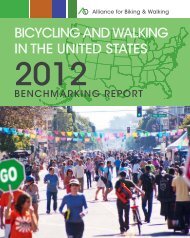Emerging Trends in Real Estate 2012 - Urban Land Institute
Emerging Trends in Real Estate 2012 - Urban Land Institute
Emerging Trends in Real Estate 2012 - Urban Land Institute
You also want an ePaper? Increase the reach of your titles
YUMPU automatically turns print PDFs into web optimized ePapers that Google loves.
Chapter 4: Property Types <strong>in</strong> Perspective<br />
driv<strong>in</strong>g traffic and sales. The mass distribution centers would<br />
provide greater convenience for shoppers who order onl<strong>in</strong>e.<br />
“They can pick items up for more <strong>in</strong>stant gratification or return<br />
them easily without the hassle of wait<strong>in</strong>g <strong>in</strong> l<strong>in</strong>es.” Many tired<br />
malls sell<strong>in</strong>g commodity merchandise should be adapted to<br />
serve as multifaceted town centers with education, community,<br />
or medical facilities, tak<strong>in</strong>g advantage of their often pivotal community<br />
locations.<br />
For <strong>2012</strong>, the fortress centers and well-situated groceryanchored<br />
retail—“like buy<strong>in</strong>g a bond”—will do well. “Neighbor hood<br />
center buyers must be extremely selective about locations,<br />
target<strong>in</strong>g assets with the top local supermarket cha<strong>in</strong>s and highest<br />
sales-per-square-foot numbers.” Major opportunities exist <strong>in</strong><br />
burgeon<strong>in</strong>g underserved or unserved Hispanic markets, especially<br />
<strong>in</strong> the Southwest and on the West Coast. “Population and<br />
<strong>in</strong>come <strong>in</strong> these communities grow ahead of national trends. The<br />
opportunity exists to stake out centers <strong>in</strong> neighborhoods, which<br />
can evolve with their demographics.”<br />
Exhibit 4-20<br />
U.S. Retail Property Total Returns<br />
50%<br />
40%<br />
30%<br />
20%<br />
10%<br />
0%<br />
-10%<br />
-20%<br />
-30%<br />
-40%<br />
1991<br />
NCREIF<br />
1993<br />
1995<br />
NAREIT<br />
1997<br />
1999<br />
2001<br />
2003<br />
2005<br />
2007<br />
2009<br />
2011*<br />
Avoid<br />
REITs strategically w<strong>in</strong>now portfolios, “sell<strong>in</strong>g cats and dogs.”<br />
Buyers should th<strong>in</strong>k twice before mak<strong>in</strong>g deals. “If the big mall<br />
companies couldn’t make them work, why should anybody else<br />
have a chance” Be very careful about upgrad<strong>in</strong>g strategies for<br />
older malls—“they probably require a different use”—and worry<br />
even more about power centers with l<strong>in</strong>eups of too many commodity<br />
retailers, which may be vulnerable.<br />
Completions (msf)<br />
Exhibit 4-19<br />
U.S. Retail Completions and Vacancy Rates<br />
35<br />
30<br />
25<br />
20<br />
15<br />
10<br />
5<br />
0<br />
1992<br />
1994<br />
Completions<br />
1996<br />
1998<br />
2000<br />
2002<br />
2004<br />
2006<br />
2008<br />
Vacancy Rate<br />
15%<br />
12%<br />
Vacancy Rate<br />
9%<br />
6%<br />
2010 <strong>2012</strong>* 2014*<br />
-50%<br />
Sources: NCREIF, NAREIT.<br />
*Data as of June 30, 2011.<br />
Development<br />
The United States simply does not need additional shopp<strong>in</strong>g<br />
center square footage, especially <strong>in</strong> old formats. Space per<br />
capita will undergo a major squeeze-down for the foreseeable<br />
future, but plenty of opportunity exists for redevelopment<br />
and redesign. Construction lend<strong>in</strong>g will be bifurcated: smaller<br />
players will have trouble scroung<strong>in</strong>g f<strong>in</strong>anc<strong>in</strong>g from local and<br />
regional banks, whereas REITs and <strong>in</strong>stitutional owners can<br />
access credit l<strong>in</strong>es from money-center <strong>in</strong>stitutions. Malls can<br />
re<strong>in</strong>vent themselves quickly, so expect local operators with<br />
reuse ideas to work with local governments on convert<strong>in</strong>g class<br />
C and D malls and attempt to turn around tax-base dra<strong>in</strong>s.<br />
“Some properties won’t make it.” “Luddites can build more<br />
traditional centers outside North America” <strong>in</strong> underserved,<br />
develop<strong>in</strong>g regions. Brazil is call<strong>in</strong>g.<br />
Outlook<br />
“Very profound structural challenges” (onl<strong>in</strong>e retail<strong>in</strong>g competition)<br />
will cont<strong>in</strong>ue to push “transformative, not cataclysmic”<br />
change <strong>in</strong> the shopp<strong>in</strong>g center world. “Outside of A/B+ malls<br />
[controlled by a REIT oligopoly] and select cash-cow neighborhood<br />
strip centers,” the “environment looks very rugged.”<br />
Although the recession claimed surpris<strong>in</strong>gly few casualties,<br />
players “require clear-eyed realism” to recognize and capitalize<br />
on changes, or they could lose ground quickly.<br />
Source: REIS.<br />
*Forecast.<br />
<strong>Emerg<strong>in</strong>g</strong> <strong>Trends</strong> <strong>in</strong> <strong>Real</strong> <strong>Estate</strong> ® <strong>2012</strong><br />
55




